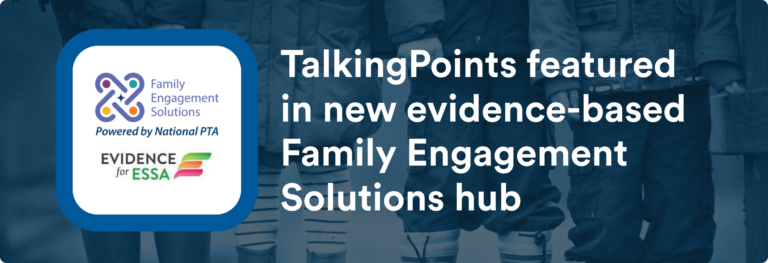by Leah Walker and Adrienne Luczkow
Decades of research have highlighted the importance of family engagement with schools.1,2 The research suggests that the reason that family engagement works to improve student outcomes is that it helps families and schools to co-create more impactful instructional strategies and more inclusive school policies and procedures. This logic is reflected in best practices which recommend that schools and families communicate about student learning and behavior3 and research has shown the importance of doing so in a positive way.4,5,6
So even though technology has made it easier for parents and families to communicate more often, how well do their conversations cover these important topics in productive ways?
How do teachers and families actually engage in the real world?
As a universal family engagement technology platform, TalkingPoints is uniquely positioned to explore this question by studying how teachers and families actually engage with each other in the real world. We set out to better understand the content of the millions of conversations between educators and families on our platform and share what we learned with educators to help inform their family engagement activities.
How we used AI to explore school-home conversation dynamics
We analyzed de-identified data consisting of 40,000,000 messages sent on the TalkingPoints platform over a 15-month period. We then used NLP techniques and leveraged machine learning tools to train, test, and ultimately use models specifically designed for sentiment and topic classification. With the help of Google’s AutoML service and well-established repositories like TweetEval, we were able to categorize each of the 40,000,000 according to topic (e.g., academics, behavior, logistics, etc.) and tone (positive or negative).
What we learned from the data
The data revealed interesting patterns that can inform recommendations to build and strengthen relationships between educators and families. For more, see the recording of our webinar Family Engagement: Is more really more? An analysis of quality vs. quantity dynamics in school-family communication where we shared some of our findings, and view the webinar companion guide.
Finding 1: Most conversations between teachers and families were about something other than student learning.
More than three out of four messages – 78% – discussed logistics (“The homework is on Google Classroom.”) or were standard replies (“Thanks for the update.”). Meanwhile, only eight percent of conversations focused on academics; two percent discussed behavior.
- While sharing logistics information is important for communicating day-to-day information families need, proportionately, the conversations about student learning and classroom engagement are happening far less frequently.
- On an encouraging note, we found more emphasis on learning and behavior conversations among families with older students. Families with middle and high school children (6th to 12th grades) engaged in many more conversations about academics, homework, and behavior (24% of all messages) compared to similar messages for families with younger learners (11% of all messages). So middle and high school families are discussing learning and behavior at higher levels, which is positive; nevertheless, the low overall percentage reflects room for improvement.
Finding 2: Overall, we found a 5:1 ratio of positive to negative messages, which aligns with best practice recommendations for building trust in school-family relationships. The exception to this finding was conversations about student behavior, which were more often negative in tone.
- The conversations about academics, homework, and assessment were largely positive in tone (91% and 87%, respectively).
- By contrast, fewer conversations about behavior and class participation were positive. Only 57% of messages about class participation and 56% about behavior were positive. This may indicate that behavior messages are sent primarily when there is an issue.
Recommendations
Based on these findings, we recommend the following to increase emphasis on the high-impact conversation practices that lead to improved student outcomes:
Prioritize opportunities to discuss student learning and behavior:
- Educators should intentionally connect with each family regularly and consistently to share information about their student’s learning and behavior and to learn more about each student’s needs. In addition, schools should encourage families to initiate conversations with teachers and to share insights about their child’s strengths and struggles. These conversations can help deepen the partnership between school and home and improve student outcomes.
Give praise as often as you can:
- Research shows that sharing positive behavior feedback with families helps spark more conversations at home between families and students, which in turn encourages students to feel more motivated and engaged in their learning. Sharing positive messages early and often about student behavior and engagement can help educators build relationships with families and motivate students. Conversely, waiting until there is a problem to communicate behavior updates with a family can work against this virtuous cycle. When a family’s primary communication with their child’s teacher is about behavior problems with their child, it can lead to mistrust and make it more difficult to form an effective partnership.
Conclusion
As part of our ongoing efforts to support building collaborative relationships between families and schools, we analyzed the more than 40 million messages they have sent to each other and now better understand the character of those conversations.
Inevitably, in any given week or month, teachers will have to communicate some good news, some bad news, some logistical information, and some academic updates. And while the data here can’t reveal what a “good” message is, it can see if the overall proportion of message type and tone is aligned with what research shows is the most likely to contribute to the outcomes families desire for their children. And it can help identify opportunities to use these conversations to address important behavior and academic progress.
Looking ahead
Working with our school district partners and with guidance from TalkingPoints advisor and acclaimed Harvard researcher Dr. Karen Mapp, our upcoming research will describe the relationship between these conversation patterns and student outcomes. By collaborating with partners on understanding how communication can improve student outcomes, we will co-create new best practices and share these widely to equip schools and districts with actionable strategies they can use to build strong family-school partnerships.
Sources:
- Henderson, A. T., & Mapp, K. L. (2002). A New Wave of Evidence: the Impact of School; Family;, and Community Connections on Student Achievement. National Center for family & community connections with schools.
- Mapp, K.L., Cuevas, S., Henderson, A., Franco, M.C., Ewert, S. (2022) Everyone Wins!: The Evidence for Family-School Partnerships and Implications for Practice.
- National Parent-Teacher Association (2022). PTA National Standards Overview. Retrieved from https://www.pta.org/docs/default-source/files/runyourpta/2022/national-standards/standards-overview.pdf
- Ames C., Khoju M., Watkins T. (1993). Parent involvement: The relationship between school-to-home communication and parents’ perceptions and beliefs Report No.: 15. Available at: http://files.eric.ed.gov/fulltext/ED362271.pdf.
- Kohl G. O., Lengua L. J., McMahon R. J. (2000). Parental involvement in school: conceptualizing multiple dimensions and their relations with family and demographic risk factors. J. Sch. Psychol. 38, 501–523. Pub Med Central
- Hoover-Dempsey K. V., Walker J. M. T. (2002). Family-school communication: A report for the Metropolitan Nashville Public Schools. (Tennessee: Paper prepared for the Research Committee of the Metropolitan Nashville/Davidson County Board of Public Education; ). Google Scholar
About TalkingPoints
TalkingPoints is an education technology nonprofit that drives student success by removing critical barriers to equitable family-school partnerships, such as language, time, mindsets, and capacity. Ten of the country’s twenty largest school districts trust TalkingPoints to create a district culture where all families, no matter their background, can engage with their schools. Our simple, intuitive family engagement platform offers the highest-quality human- and AI-powered two-way translated communication available — in 150 languages and counting. Named by Common Sense Education as “the best overall family communication platform for teachers and schools”, TalkingPoints leads to higher test scores and lower absenteeism, as shown by rigorous causal research that meets the ESSA Tier 2 standard of evidence. To learn more, view our TED Talk or visit talkingpts.org



